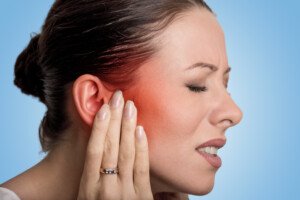
It’s happens: Someone is diagnosed with TMJ disorder but later learns it’s a misdiagnosis of a very serious disease, like a brain tumor or heart problem.
The symptoms of temporomandibular joint disorder are very similar to the symptoms of more serious medical conditions.
The fewer the symptoms that a person has, the more likely they can be explained by a condition other than TMJ disorder.
For example, if you have pain chewing, pain opening your mouth, a clicking noise when you open your mouth, a misaligned bite and new-onset headaches…you’re FAR more likely to have temporomandibular joint disorder than a brain tumor.
However, if your only symptom is the new-onset headaches, the likelihood of these being from TMJ disorder drops, and the odds of a brain tumor go up – but keep in mind that all in all, in general, the cause of new-onset headaches is most likely not a brain tumor.
It’s just that TMJ disorder as a possible cause of only one symptom—headaches—is nothing to bet on.
“Several diseases and disorders can mimic TMJ disorders including a heart attack, benign tumors, malignant tumors (metastasis, brain cancer), degenerative joint diseases, fibromyalgia, Lyme disease, salivary gland diseases, temporal arteritis (blindness in a few days if untreated), migraine and cluster headaches, trigeminal neuralgia,” says Brijesh Chandwani, DMD, BDS, Diplomate, American Board of Orofacial Pain, with Connecticut & NY TMJ.
“Often at times, TMJ pain or discomfort is the only symptom present, but at other times red flags such as numbness, dizziness, swelling, changes in bite, fever, body malaise, pain in other parts of the body, etc., are present,” says Dr. Chandwani.
Brain Tumors & Other Serious Diseases Masquerading As TMJ Disorder
“A small proportion of patients with orofacial pain appearing to dentists will have intracranial tumors as the underlying cause,” says a paper in Oral Surgery, Oral Medicine, Oral Pathology, Oral Radiology (Dec. 2012).

Shutterstock/Rocketclips, Inc.
“These patients may undergo unnecessary dental interventions before the correct diagnosis is made,” states the paper. These conclusions are based on a review of 28 cases of orofacial pain.
Another issue of this journal (Nov. 2003) states: “When diagnosing patients with TMD symptoms, we must consider the possibility of unusual causes, including tumors and infections or inflammations.”
Cellulitis is one such infection that can be misdiagnosed as TMJ disorder, and it’s a bacterial infection of the skin and tissues under the skin.
And should we be surprised that melanoma makes the list of serious medical conditions that can mimic the symptoms of TMJ disorder?
Yes, it figures, because melanoma (skin cancer) is notorious for metastasizing.
A paper in the Journal of the American Dental Association (Oct. 2014) describes a case in which melanoma had been misdiagnosed as TMJ disorder.
“Malignancies in the head and neck region are difficult to diagnose because of their deep location and presence of symptoms mimicking temporomandibular disorders or other orofacial pain disorders,” says the paper.
The case was a patient with right side jaw pain, temporal discomfort and tingling sensation.
When TMD treatment failed, an MRI revealed a tumor at the base of her tongue plus melanoma metastasis to the brain.
This is scary sh** but it’s knowledge that you should have in the event that your TMJ symptoms are not responding to dental treatment.
Heart Problems Can Mimic TMJ Disorder
It’s frightening to hear you have something wrong with your heart, but it beats hearing that you have a brain tumor.
“Dental practitioners can play a crucial role in the diagnosis of craniofacial pain of cardiac origin,” says a paper in The Australian Dental Journal (May 2012).
The paper states that the left jaw was a frequent site of pain stemming from ischemic heart disease.
The ADJ, as well as the Journal of Clinical and Experimental Dentistry (Jan. 2017), point out that craniofacial pain may be the ONLY symptom of ischemic heart disease.
Areas that Can Be Affected
• Left, but also the right, jaw, though studies show that the left side is more commonly affected.
• Toothache on both sides of the mouth
• Front and back of the neck
• Upper throat
• It is entirely possible for chest pain to be absent, while ONLY jaw pain is present, from coronary artery disease.
• Craniofacial pain can be on one or both sides.
• Presence or absence of diabetes, high blood pressure or family history of heart disease is not predictive of orofacial pain of cardiac origin.

Dr. Chandwani has 15+ years of experience focusing on TMJ disorders and sleep disorders.
 Lorra Garrick has been covering medical, fitness and cybersecurity topics for many years, having written thousands of articles for print magazines and websites, including as a ghostwriter. She’s also a former ACE-certified personal trainer.
Lorra Garrick has been covering medical, fitness and cybersecurity topics for many years, having written thousands of articles for print magazines and websites, including as a ghostwriter. She’s also a former ACE-certified personal trainer.
.


























